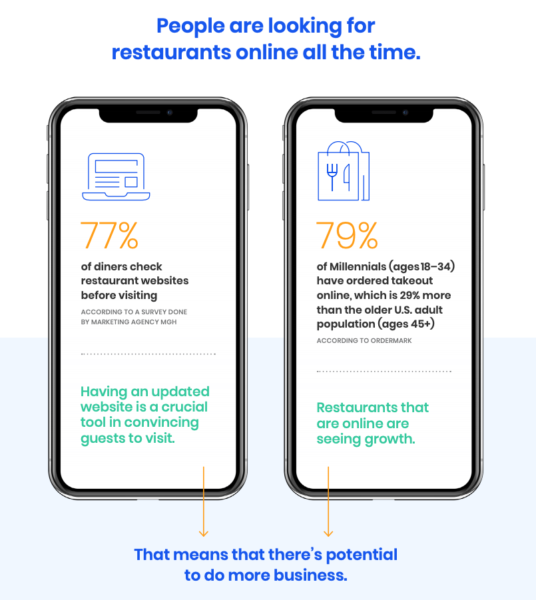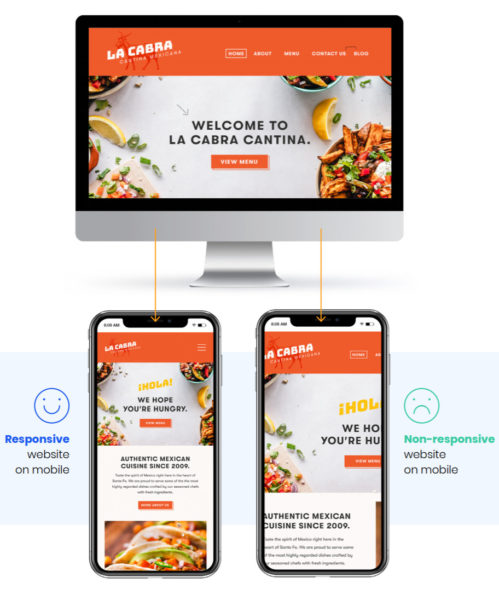
Did you know that an estimated 236 million people in the United States use search engines to decide where they want to eat and shop? That’s a staggering statistic, and great news for your restaurant — if you know how to use restaurant search engine optimization to help those people find you.
Used effectively, search engine optimization (or SEO) can direct thousands of potential customers to your restaurant. Best of all, restaurant SEO requires little or no money for business owners to do.
In this article, we’ll cover what SEO is, how it’s used in the restaurant business, and how you should use SEO to make sure your restaurant is found by local customers using search engines.
What is search engine optimization (SEO)?
Search engine optimization is a digital marketing technique that helps your website be more visible in online search results. By using effective SEO techniques, the goal is to get your business to appear on the first search engine results page (SERP) that comes up when someone searches for keywords or services you provide. This increases your business’ online visibility and makes it more likely that potential customers will be able to find you.
In order to optimize your website for search engines, you first need to have a general idea of how search engines work. Basically, search engines, such as Google, use bots to collect information from different websites. These websites are then put into an index and analyzed by algorithms that determine what order the websites appear in search results for different queries.
Some of the criteria search engines use to rank websites include how informative they are, how well structured they are, and how often other sites link back to them. Search engines also examine the keywords or keyword phrases your web pages use to see if they match up with the words and phrases people type into search engines. Having a mobile-friendly website is also important, as more and more people search for websites on their smartphones.
How can restaurant SEO help your business?

When you consider that up to 77% of diners look at a restaurant’s website before visiting, it’s vital that your website be easy to find in online searches. To optimize your website for search engines, keep the following tips in mind.
Offer informative content
Make sure your restaurant’s website provides the content and value search engines and potential customers look for. This means highlighting the following topics:
- Your restaurant’s brand story: Spotlight what makes your restaurant unique. If your business is a family restaurant that’s been around for decades, emphasize this. If you take pride in using only organic ingredients, describe how you source and cook them. Your brand story is a big selling point for your business, so make sure your content emphasizes what makes you special.
- Location, business hours, and contact information: Patrons need to find your address and phone number easily, so make sure this information appears prominently on your homepage. The same goes for business hours. Also, be sure to note if your menu changes at different times of the day.
- Your menu: Make sure your menu is on one page to make it easier to navigate. Your menu should also not be in PDF format as PDF text is not readable by search engine bots and is harder to display on mobile devices.
- Reservation instructions: Customers appreciate being able to make reservations directly on your website. Make this something they can do with just one click on their mobile device.
- Online ordering: Up to 79% of millennials order food online through apps. People who order from a restaurant online are also likely to return to that restaurant again. As ordering out becomes more common, having an online ordering app on your website is crucial.
- Email list sign–up: An email list enables you to connect on a regular basis with your customers by informing them of special events or new dishes. Effective email list sign-ups are easily accessible through mobile devices and offer an incentive for customers to provide their email address (such as a discount on their first order).
Customers also need to know about your in-person dining options in the COVID-19 era. Make sure to communicate that you’re following CDC guidelines for safely reopening your business. Let your customers know about seating arrangements and how many people your restaurant can seat safely. Your mask-wearing policy should also be clearly stated on your website.
Curbside pickup and delivery options are also more relevant in this “new normal.” Make sure your website informs your customers of all the dining options your restaurant provides. This is also a great place to showcase your online ordering app.
Use relevant keywords and key phrases
Your website content should also include the keywords and key phrases your potential customers type into search engines when looking for a restaurant like yours. These key phrases include niche keywords that describe your type of restaurant. Depending on the type of food you serve, you might use the following types of niche-specific keywords and key phrases in your website copy:
- “Vegan restaurant”
- “Thai food restaurant”
- “Best sushi restaurant”
Your restaurant’s name also provides you with brand-related keywords that should be emphasized on your website. This will make it easy for customers to find your website if they search for your restaurant specifically.
Most importantly, you want to use local SEO keywords. Local SEO is the process of optimizing your website so it directs local online searches toward your business. To do this, use keywords that emphasize your restaurant’s location. If you run a Greek restaurant in Phoenix, you might use the following key phrases on your website:
- “Restaurant in Phoenix”
- “Restaurant that offers curbside pickup in Phoenix”
- “Greek restaurant in Phoenix”
- “Best baklava in Phoenix”
Claim and update your business profile listings
Another important factor for local SEO is making sure your business appears correctly in directory listing and review sites.
Directory listing sites act like online phone books to gather information on businesses, such as name, phone number, address, and business hours. Review sites also offer this information along with menus, photos, and most importantly, reviews and ratings from your customers.
Other sites and search engines, including Google search, reference these listings to determine whether or not your business is popular with locals or near someone who is searching for relevant keywords. They’ll prioritize businesses with correct, updated information and high ratings above those with low ratings or outdated information.
Yelp, Facebook Business, and Google My Business are some of the most important sites like this. Your restaurant likely already has a profile on these sites, whether you set it up or not. Make sure to claim your restaurant’s listings so you can keep the information on them updated and also respond to questions or reviews from customers.
Make your website mobile-friendly
According to Hitwise, 72% of online searches are initiated on mobile devices. Having a mobile-responsive website is vital for restaurant SEO. Mobile-responsive websites adapt to the devices they’re being viewed through, making it easy for your potential customers to scroll through your content and find what they’re looking for. Search engines also prioritize mobile-responsive sites over websites that aren’t mobile-optimized.

Designing a search-optimized restaurant website
Restaurant SEO is a powerful and cost-effective way of increasing your online presence and directing more potential customers to your business. By providing the content your customers are looking for, keeping your business information up-to-date, and offering a mobile-responsive website, you can make your restaurant much easier for thousands of potential customers to find.




